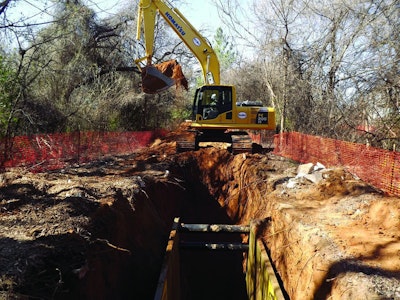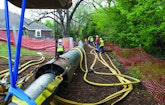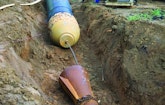
Interested in Municipal/Industrial?
Get Municipal/Industrial articles, news and videos right in your inbox! Sign up now.
Municipal/Industrial + Get AlertsThe Trinity River Authority of Texas wanted to upsize a 24-inch reinforced concrete sewer interceptor to accommodate projected development in the City of Fort Worth. The 43-year-old pipe, which ran through Stone Creek Park, also had root intrusion, bellies and offset joints.
Engineers specified pipe bursting to preserve a playground, a concrete trail and as many trees as possible. No-DigTec of Dallas won the bid to install 1,175 feet of 28-inch, 1,826 feet of 32-inch, and 260 feet of 34-inch DR-17 high-density polyethylene pipe. Shorter runs of the latter reduced turbulence where other lines connected to the 32-inch interceptor.
“The 34-inch bursts were a first for HammerHead Trenchless Equipment and us,” says No-DigTec owner John Newell. “Besides logistical and site challenges, upsizing the bursting head five times and the weight of the pipe – 2 tons per 50-foot stick – stressed men and equipment. There was nothing we could move by hand.”
Newell’s 10-member crew battled massive tree roots, constricted work areas and a two-month delay to meet the April 30 deadline to vacate the park.
By the numbers
Every phase required approval from the city’s Parks Department. Officials told No-DigTec to stake out the location of entry and pulling pits, but the dense underbrush was impassable. Workers hacked their way through it with machetes. “The area had 3-inch-long thorns that punctured rubber tires,” says Newell. “One even went through a guy’s shoe.” The injury was minor.
Per instructions, senior project manager Jason Williford of Mountain Cascade Construction in Mansfield, Texas, hired an arborist to grub out 15-foot-wide paths and trim or cut down trees. Newell often found trees trimmed too low for the two Komatsu PC200 LC tracked excavators to pass without tearing off limbs, or paths not large enough to accommodate the machines’ 30-foot turn radius.
“Damaging trees carried penalties of $400 per inch of trunk circumference,” says Newell. “To protect them, we laid timber matting over root zones, spread mulch on paths, wrapped wood armor around trunks and fenced off restricted areas.” Clearing paths took two months.
The right stuff
The project’s multiple upsizes required a pipe pilot to center the new pipe, a specially sized bursting head/full body expander and a rear-mounted assist hammer. Twin blades on the pilot broke the host pipe’s 3-inch-thick wall and 5-inch-thick bells.
HammerHead engineer Mark Randa recommended a 38-inch expander head, a 26-inch pneumatic Mole rammer driving at 122 beats per minute and the lubrication system. “The larger rammer slips inside the head, while my 20-inch Mole rammer ran through casing and attached to the rear of the HDPE pipe to help push it and alleviate drag,” says Newell.
The system was powered by three Sullair portable air compressors blowing instrument-quality air to help cool the rammers. Two 1600H (1,600 cfm/150 psi) compressors drove the larger rammer, while a 750H (750 cfm/150 psi) unit drove the smaller unit. “Heat causes expansion, which causes power loss because the rammers no longer fit tightly against the seals on the strikers,” says Newell. “Cooling the rammers increased our chances of completing bursts without stalling.”
The lubrication system mixed environmentally safe dishwashing liquid with water, then pumped it to a nozzle at the back of the bursting head. “The solution squirts out and runs down the HDPE pipe to reduce drag,” says Newell. “It works as well as a polymer lubricant at a third of the cost.”
Planning ahead
Four No-DigTec workers arrived on March 10 and began fusing pipe in a large open area 1,000 feet from the nearest entry pit (the farthest was 2,500 feet away). Each joint took an hour to complete. Meanwhile, a second crew built two bridges across a creek running through the park. They laid three 12-inch pipes lengthwise in the shallow water, then cut down the 10-foot-high banks with a Komatsu PC200 excavator, compacting the soil to form a road.
The PC200 excavators were almost as wide as the paths, requiring someone on foot to help guide the driver to entry or exit pit locations. Digging took three times as long as usual. The operator dumped each bucketful behind the excavator, then swung around for the next scoop. Another operator with a loader stockpiled the sandy soil in a designated area for use as backfill.
The 60-foot-long entry pits and 36-foot-long exit pits were 10- by 15-feet deep. The project required 10 pits, five at manhole locations. After some pulls, workers enlarged the exit pit to serve as the entry pit for the next burst.
The narrow paths necessitated moving equipment into position before dragging in the pipe. “It was impossible to inch anything past it,” says Newell. “If we forgot something, we were in trouble.”
Success at hand
To prevent the 8,780-pound HydroGuide HG20 20-ton winch from sinking in the sand, workers laid steel plates to distribute the weight. Other times, they positioned the trailer-like unit over a trench box, then lowered the adjustable boom that guided the 7/8-inch swage cable.
Workers threaded the cable by pushing a BES FiberSnake duct rodder to the entry pit. “The rodder navigates root intrusion and has enough power to drag back a 3/8-inch cable,” says Newell. “Then we attach the smaller cable to the larger one and pull it to the entry pit with an excavator.” Each burst took a week of preparation.
Although Newell preferred pulls of 400 to 500 feet, something was always in the way. Of the 10 bursts, the longest was 325 feet of 34-inch pipe and the two shortest were 200 feet of 32-inch pipe. The latter also were the most critical, passing beneath mature trees with massive living roots encasing the host pipe.
Newell’s greatest concern was if the roots stretched instead of tore during the burst. Then they would return to their original shapes, squeezing the replacement pipe and creating drag. “There was no room for error,” he says. “If we stalled out and had to excavate, I’d be hanging from the remaining tree.”
Beginning both pulls as close to a tree as possible enabled Newell to concentrate all the rammer’s power on breaking through the root bundles. The winch is rated at 28 feet per minute, but the bursts were so difficult that pulls progressed at 12 inches per minute with the pressure holding at 15 tons of pulling force.
“It was a great relief to complete the project, and Mark’s equipment recommendations and support were vital to our success,” says Newell. “We have a new appreciation for his pipe bursting system."









